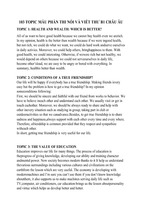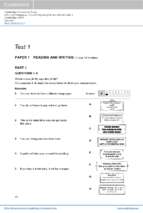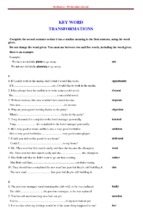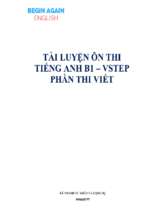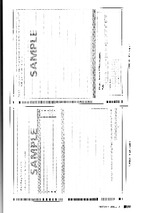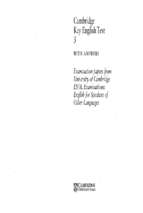VIETNAM NATIONAL UNIVERSITY, HANOI
VIETNAM JAPAN UNIVERSITY
NGUYEN THI DANG HUE
AWARENESS AND WILLINGNESS TO
REDUCE SINGLE-USE PLASTIC IN
HANOI IN RELATION TO CLIMATE
CHANGE MITIGATION
MASTER’S THESIS
VIETNAM NATIONAL UNIVERSITY, HANOI
VIETNAM JAPAN UNIVERSITY
NGUYEN THI DANG HUE
AWARENESS AND WILLINGNESS TO
REDUCE SINGLE-USE PLASTIC IN
HANOI IN RELATION TO CLIMATE
CHANGE MITIGATION
MAJOR: CLIMATE CHANGE AND DEVELOPMENT
CODE: 8900201.02QTD
RESEARCH SUPERVISOR:
Dr. TAKEUCHI RYO
ASSOC.PROF. TAMURA MAKOTO
Hanoi, 2020
PLEDGE
I declare that this master thesis has conducted by the author. This result has
not submitted to any papers and hasn’t published yet. The references and
citations from research paper, book, report, websites were in the list of
references of the thesis.
Author of the thesis
Nguyen Thi Dang Hue
i
TABLE OF CONTENT
PLEDGE............................................................................................................. i
TABLE OF CONTENT .................................................................................... ii
LIST OF FIGURES.......................................................................................... iv
LIST OF ABBREVIATIONS .......................................................................... vi
ACKNOWLEDGMENT ................................................................................. vii
CHAPTER 1: INTRODUCTION ..................................................................... 1
1.1 Research background .............................................................................. 1
1.2. Motivation .............................................................................................. 3
1.3. Purpose of the study ............................................................................... 4
1.4. Scope ...................................................................................................... 4
1.5. Research questions ................................................................................. 5
1.6. Hypothesis .............................................................................................. 5
1.7. Structure of the thesis ............................................................................. 5
CHAPTER 2: LITERATURE REVIEW .......................................................... 7
2.1. Single – use plastic ................................................................................. 7
2.1.1. Plastic bags ...................................................................................... 9
2.1.2. Plastic takeaway food containers ................................................... 12
2.2. Plastic issue and climate change .......................................................... 13
2.2.1. Heat emissions from crude oil making .......................................... 13
2.2.2. Greenhouse gases emission from plastic waste treatment............. 14
2.2.3. Greenhouse gases emission from plastic ....................................... 16
2.2.4. Impact on the oceanic carbon sink ................................................ 17
2.3. Waste management in Vietnam............................................................ 19
2.4. Mitigating plastic related greenhouse gas emissions ........................... 21
CHAPTER 3: METHODOLOGY .................................................................. 25
3.1. Research process .................................................................................. 25
3.2. Sampling and data collection ............................................................... 25
3.3. Questionnaire design ............................................................................ 26
3.4. Statistic method .................................................................................... 26
3.5. Expert method ...................................................................................... 27
3.6. Study site .............................................................................................. 27
CHAPTER 4: RESULTS ................................................................................ 29
4.1. Background information....................................................................... 29
4.2. Consumption behavior ......................................................................... 30
ii
4.3. Environmental impacts awareness ....................................................... 39
4.4. Willingness to reduce ........................................................................... 42
4.4.1. Single – use plastic container ........................................................ 42
4.4.2. Single – use plastic bag ................................................................. 47
CHAPTER 5: DISCUSSION .......................................................................... 52
CHAPTER 6: CONCLUSION AND RECOMMENDATION ...................... 58
6.1. Conclusion and recommendation ......................................................... 58
6.2. Limitation ............................................................................................. 60
REFERENCES ................................................................................................ 62
APPENDIX ..................................................................................................... 67
iii
LIST OF FIGURES
Figure 2.1: Disposal of all plastic waste generated in 2015 ............................. 7
Figure 2.2: Single- use plastic bags life cycle................................................. 11
Figure 2.3: Plankton processes ........................................................................ 18
Figure 2.4: Waste collection process .............................................................. 20
Figure 2.5: Net greenhouse gas emissions from source reduction and
municipal solid waste management option ..................................................... 22
Figure 3.1: Research process proposed by the author..................................... 25
Figure 4.1: Gender and aged of respondent .................................................... 29
Figure 4.2: Education level ............................................................................. 30
Figure 4.3: Number of single - use plastic container per week in general ..... 30
Figure 4.4: Number of single - use plastic container used base on gender per
week................................................................................................................. 31
Figure 4.5: The number of containers use base on ages ................................. 32
Figure 4.6: Reusable container usage ............................................................. 32
Figure 4.7: The reasons for bring reusable container ..................................... 33
Figure 4.8: The reason for not bring reusable container ................................. 34
Figure 4.9: Number of plastic bags used per week ......................................... 35
Figure 4.10: Plastic bags usage base on gender .............................................. 36
Figure 4.11: Plastic bag used after carrying .................................................... 36
Figure 4.12: Reusable bags usage status ......................................................... 37
Figure 4.13: The reason for not bringing reusable bags ................................. 38
Figure 4.14: Environmental impact awareness ............................................... 39
Figure 4.15: Environmental impact awareness with detail ............................. 39
Figure 4.16: Important of the environmental issue (on a scale from 1 to 5) .. 40
Figure 4.17: Sources of information ............................................................... 41
Figure 4.18: Shopping priority ........................................................................ 42
Figure 4.19: Willingness to reduce single – use plastic container .................. 43
Figure 4.20: Willingness to reduce single – use plastic container based on
gender .............................................................................................................. 44
Figure 4.21: Willingness to reduce plastic container based on age ................ 44
Figure 4.22: Willingness to cooperate by paying for single - use eco-friendly
container .......................................................................................................... 45
Figure 4.23: Education level and willingness to cooperate by paying for
single–use eco-friendly container ................................................................... 46
iv
Figure 4.24: Willingness to reduce the usage of single – use plastic bag in
general ............................................................................................................. 47
Figure 4.25: Willingness to reduce the usage of single – use plastic bag based
on gender ......................................................................................................... 47
Figure 4.26: Willingness to reduce the usage of single – use plastic bag based
on ages ............................................................................................................. 48
Figure 4.27: Willingness to cooperate to stop taking plastic bag at the
shopping places ............................................................................................... 49
Figure 4.28: Education and willingness to cooperate by how people accept to
stop taking plastic bag at the shopping places ................................................ 49
Figure 4.29: The acceptance of strategies to reduce plastic bags ................... 50
v
LIST OF ABBREVIATIONS
CO2
CO2e
EPS
GAIA
GHG
HDPE
IPCC
LDPE
LLPE
Mt
MONRE
kWh
PE
PET
PLA
PS
PVC
WRAP
ATSDR
Carbon dioxide
Carbon dioxide equivalent
Expanded polystyrene
Global Alliance for Incinerator Alternatives
Greenhouse gas
High-Density Polyethylene
Intergovernmental Panel on Climate change
Low-Density Polyethylene
Linear Low-Density Polyethylene
Metric ton
Ministry of National Resources and Environment
kilowatt - hour
Polypropylene
Polypropylene terephthalate
Polylactic acid
Polystyrene
Polyvinyl chloride
Waste and Resource Action Program
Agency for Toxic Substainces and Disease Registry
vi
ACKNOWLEDGMENT
I’m grateful to our faculty lectures of the Master in Climate Change and
Development Program, Vietnam Japan University, who has given me many
guidance to process my project.
I’m very thankful to my supervisors - Dr. Ryo Takeuchi and Assoc.Prof.
Makoto Tamura, who provided insight and expertise that greatly assisted the
research and always encourages me, and to Bui Thi Hoa – MCCD program
assistant for helping me during doing survey, and to my classmates Tieu Thi
Diu, who was patient to help me while I was processing the data. I want to
express my appreciation to the lectures, staffs in Ibaraki University and friend
especially Suziki Shunya for supporting me so much during the internship.
I would like to show my appreciation to all of friends who helps me to share
my survey, and to everyone who spend time to review and give the
comments.
Finally, I would like to express our gratitude to all the people who help me by
providing their valuable assistance and time for this study.
Nguyen Thi Dang Hue
vii
CHAPTER 1: INTRODUCTION
1.1 Research background
Increasing plastic waste poses threat to globally sustainable development as
they are destroying ocean ecosystem and sustain in the environment for
hundreds of years. Plastic production is one of the industrial production
activities causing serious pollution to the air environment (Center for
International Environmental Law, 2019). The amount of harmful emissions
with extremely unpleasant odors seriously affects the health of those exposed.
In the process of burning plastic will produce toxic substances, including 3
toxic gases: CO2, SO2 and vinyl chloride. In the long term, they also affect the
atmosphere, creating a greenhouse effect.
The plastic production in global scale has been increasing rapidly since past
50 years. When comparing the global production of 1950, which respectively
accounts for 2 million tones, annual production has increased nearly 200-fold,
reaching 381 million tones by 2015 (Plastic global production, 2018). While
the impacts of plastic waste causing to the environment, the ecosystem,
especially the marine ecosystem have been clearly shown, the effects of
plastic on climate change are gradually being clarified (Center for
International Environmental Law, 2019). The plastic production is highly
dependent on fossil coal, a non-renewable resource. In 2019, the burning and
production of plastic contributed 850 million metric tons of GHG to the
atmosphere. This is equivalent to emissions from 189 megawatt coal fired
power plant.
By 2030, this amount of emissions could reach 1.34 gigatons per year if
plastic production and use grow under the current plan. This is equivalent to
emissions from more than 295 new 500 MW coal fired power plants. By
1
2050, the accumulation of these GHGs emissions from plastics can exceed 56
gigatons per year, accounting for 10-13% of the remaining carbon budget, the
plastics industry can account for 20% of the world's total oil consumption.
The increase of GHGs emission from plastic sector will threat the ability of
global communities to limit the total global temperature rise below 2 degrees
Celsius and making efforts to stay below 1.5 degrees Celsius as the
Intergovernmental Panel on Climate Change (IPCC) in October 2018
highlighted in an IPCC special report on the impact of global warming of 1.5
degree Celsius.
In particular, plastic product packaging (plastic bags, plastic bottles, product
packaging) accounts for about 36%. Plastic construction materials, household
appliances and other types of industries such as electronics, electricity, and
transportation account for 16%, 36% and 12% respectively (United Nation
Environmental Programme, 2018). In 2015, plastic packaging waste
accounted for 47% of the world's plastic waste, half of which seemed to come
from Asia.
Vietnam, China, Indonesia and Philippines are among top 20 countries
produce the highest amount of plastic waste to ocean. Vietnam is ranked as
the fourth country that discharge plastic waste into the ocean with 1.83
million metric tons per years, after China in the first place with 8,82 million
metric tons, Indonesia in the second place with 3.22 million tons, Philippines
in the third place with 1.88 million metric tons (Jambeck et al., 2015).
According to the National Environment Report in 2015, solid waste is mainly
treated by dumping or incineration. The main sources of waste are Hanoi city,
Hai Phong city and Ho Chi Minh city. With the proportion of products in the
total volume of plastic products produced annually, plastic packaging in
2
Vietnam has an average output of about 1 million tons/year. According to
previous data, the average consumption of plastic is about 25 – 35kg
plastic/person/year. Up to now, with the growth rate of plastic industry of
about 15 – 20%/year, at the same time the economic life is growing, the
average plastic consumption reaches more than 40kg/person/year.
Along with future economic and population development, the amount of
plastic waste will also increase rapidly, while land fund for landfill is
shrinking, outdated waste treatment technology, create a heavy burden on the
environment and human health.
In addition to the single - use plastic waste treatment measures such as
applying modern treatment technology, sorting waste from sources, taxes and
prohibited laws, reducing the use of single - use plastic from consumers is a
solution in the context of a developing country like Vietnam. Therefore, it is
necessary to raise people’s awareness on environmental impact of plastic
waste and understand level of willingness to reduce the use of single-use
plastic. The study will present the current situation of single – use plastic
consumption in Hanoi. And the results will be valued as the base for policy
makers to issue regulation or to organize media campaign to reduce single –
use plastic waste.
1.2. Motivation
Given the fact that plastic pollution becomes urgent all over the world in
general and in Vietnam in particular, there is a lack of study on Vietnamese
people’s awareness on single – use plastic consumption.
In the context of the Government of Vietnam efforts to eliminate disposable
plastic year by 2025 and prevent the amount of waste spilled into the ocean by
the Prime Minister's decision to promulgate a national action plan on ocean
3
plastic waste management by 2030. On 9th June, 2019, Prime Minister
Nguyen Xuan Phuc stated Vietnam has aimed to stop selling single – use
plastic at supermarket by 2021. Hanoi City President Nguyen Duc Chung also
said Hanoi will make efforts to December 2020 to ban plastic bags in all
shopping centers. As impacted by global movement on anti-plastic waste,
Vietnamese government has organized media campaign to raise people’s
awareness on plastic waste harmfulness.
1.3. Purpose of the study
The aim of the research is to provide the information relate to Hanoi
population’s attitudes towards the consumption of single-use plastic bags by
showing their level of willingness to reduce.
This research also identified the Hanoi population’s awareness of human
health impact and environmental impacts caused by single –use plastic.
Base on the results, some recommendations will be given. This result may be
used by any organizations such as Government authorities, non-profit
organization, or individuals in order to create the strategies and take actions
based on the actual attitudes.
1.4. Scope
The study is aimed at people from 18 years old and older living in Hanoi. By
creating an online questionnaire using Google forms, both closed and open;
and face to face survey. The questionnaire will be sent to respondents via
Facebook social networks. The link to the questionnaire will be posted on the
researcher's Facebook and ask everyone in the friends list to share it with
others, to increase the diversity of respondents.
4
1.5. Research questions
1. What is Hanoi people’s perception towards the consumption of singleuse plastic and their willingness to reduce the consumption?
2. Whether is the willingness of single-use plastic bag consumption
differentiated in gender?
1.6. Hypothesis
1. People use plastic bags for convenience, also having basic knowledge
about the harmful effects of plastic waste.
2. Women and younger people have higher level of willingness to reduce
single – use plastic.
1.7. Structure of the thesis
Six chapters were designed in this thesis, as presented as below:
Chapter 1: Introduction
This chapter briefly introduces about the background of research, research
objective, research questions and scope.
Chapter 2: Literature review
This part provides the fundamental information about single – use plastic, the
relationship between plastic and climate change and reducing plastic related
climate change mitigation.
Chapter 3: Research Methodology
The process of the research, sample size and data collection, the data analysis
method are described.
5
Chapter 4: Results presentation and finding
This chapter presents the data collected and show the results after analysis
from Excel and Chi- square.
Chapter 5: Discussion
The research question will be answered in this part, adding more information
to explain and the result from expert interview.
The discussion about reducing plastic and climate change mitigation.
Chapter 6: Conclusion and recommendation
Summary the main issue from data analysis and discussion, giving some
suggestions, also limitations and further research direction.
6
CHAPTER 2: LITERATURE REVIEW
2.1. Single – use plastic
According to United Nations Environment, single-use plastics, or disposable
plastics, are used only once before they are thrown away or recycled. Single –
use plastic is made of plastic which is lightweight, sanitary, frustrate
material. These items are things like plastic bags, straws, coffee stirrers, soda
water bottles, containers, cups, cutlery and most food packaging.
In 2015, the waste of plastic packing occupied for 47% of the global plastic
waste generated, Asian a lone contributed half of the total.
9%
12%
79%
recycled
Incinerated
Landfill and dumping
Figure 2.1: Disposal of all plastic waste generated in 2015 (Roland Geyer et
al., 2017)
Once no longer in use, a product or package may be recycled, incinerated,
buried, dumped in an uncontrolled location, or disposed of into the
environment. Because of the percentage of recycling is just 9 %, 12 %, so the
most of the plastic waste was solve by landfills or dumping into the
environment (Roland Geyer et al., 2017).
7
Plastic cannot be biodegraded. It will take hundreds of years for them to split
up into small pieces that known as micro-plastics. Especially, the productions
made of expanded polystyrene foam might need thousands of years to
decompose.
If plastic waste leaks into the environment, it will cause problems. Plastic
bags can block waterways and worsen natural disasters by clogging sewers.
Plastic bags and bottles also provide breeding grounds for mosquitoes and
pests, which can increase diarrhea and infectious diseases. Polystyrene foam
products, containing carcinogenic chemicals like styrene and benzene, are
highly toxic when ingested and can damage the nervous system, lungs and
reproductive organs. The toxins in the foam can seep into food and drinks. In
poor countries, plastic waste is often burned by heat and cooking, and people
are exposed to toxic gases. Burning and disposing of plastic waste in an
outdoor pit releases toxic gases such as furan and Dioxin. (United Nation
Environmental Programme, 2018).
The application of plastic for single – use production is various. LDPE is
material for plastic bags, trays, food packing film and containers. Water
bottles and other drinks, biscuit trays, dispensing boxes for cleaning fluids are
made of PET. Milk bottles, bags for freezers, soap bottles, ice cream
containers are made of HDPE. PS can be used to make cutlery, plates and
cups. EPS is applied to produce hot drinks cups, insulated food packing,
fragile items with protective packing. There are some familiar products like
microwave dishes, ice cream tubs, potato chip bags, bottle caps are made of
PP.
8
2.1.1. Plastic bags
According to Oxford dictionaries in 2017, plastic bags are given freely at
places of sale for customers to contain and carry goods. Plastics are obtained
by ethylene polymerization. The characteristic of plastic bag is thin, light,
tough, waterproof and cheap compared to other materials. Grocery stores are
generally the largest single-use consumer markets (Wagner, 2017).
When it first came out, plastic bags were considered an alternative to paper
bags at the time to reduce deforestation and timber in the 1960s. When at that
time, paper bags were the common way to carry and carry things (Petru,
2014). When it was first launched in the US in the 1970s, plastic bags were
not quickly accepted by consumers at the time. Manufacturers of plastic bags
have resorted to media campaigns to try to change consumer attitudes in
actively accepting plastic bags. It was not until 1977 that American
supermarkets began to provide plastic bags to consumers when shopping.
Europe began to supply them consistently in the 1980s. In the 1990s,
developing countries began to popularize plastic bags. Today, plastic bags
become popular worldwide with between 500 billion and 1.5 trillion plastic
bags used for shopping each year (Jennifer Clapp et al., 2009).
Single-use plastic bags are widely used because they are tough, cheap and
hygienic to transport goods. Plastic grocery bags consume less energy and
water to produce and produce less solid waste than paper bags, taking up less
space in landfills. The advantages of plastic bags have helped them to be
widely consumed and become globally popular. However, they are also
difficult to recycle and adversely affect the environment, especially when we
lack in management (United Nation Environmental Programme, 2018).
9
According to zero waste Europe, there are three basic types of normal plastic
bags and 1 type of degradable plastic bags. In particularly, High Density
Polyethylene (HDPE) bags are used for making unbranded bags and is often
used in markets, service stations and grocery stores. HDPE bags are produced
from ethylene and are by-products of gas or oil purification. In the US, these
types of bags used in grocery stores and supermarkets usually have a
thickness from 0.7 to 1.75 mils, including the handle straps. The fact that
these types of bags have handles to distinguish them from bags used only to
wrap foods such as vegetables, meat, fish at each counter to bring to the
cashier. Low Density Polyethylene (LDPE) bags are branded printed bags and
are used at places that sell higher value goods at shopping malls or stores.
These types of bag usually have a thickness range from 2.25 to 3 mils in
general. LDPE is also a side product of gas or oil filtration and is also made
from ethylene (Wagner, 2017). Non-woven Polypropylene is the type of
plastic used to make reusable bags.
In recent years, biodegradable plastic bags are also a product of public
attention to replace conventional plastic bags. These types of bags have the
ability to decompose through the action of bacteria, algae, fungi. Synthetic or
biological polyesters such as potatoes, corn, sugar are material to make
biodegradable bags (ICF, 2010). However, biodegradable bags cost more than
plastic bag; therefore, the manufacturers and retailers are not interested in
promoting the use of bio-bags (MESTECC, 2018).
The recycling rate of plastic bags is quite low. There is no exact statistics on
the number of plastic bags once recovered and reused. According to a report
by the US Environmental Protection Agency, 2015 plastic bag recovery rate
was 12.3%, down 1.2% compared to 2013 (US EPA, 2015). Normally, if
plastic bags are collected and recycled, they will have to be sorted at source to
10
avoid mixing with other types of recycling, affecting quality. However, the
cost for sorting is high and the recycling value of plastic bags is very low.
Therefore, plastic bags are considered as disposable products. The recycling
of plastic bags is mainly based on individual people, which can be used more
than once, such as storage of household items, garbage, and containers when
taken out (WRAP, 2015).
Nevertheless, even when plastic bags can be reused, it depends on the
consumer's personal awareness and it is important that they still become
garbage in landfills, in incinerators or thrown out into the environment. From
a study of ICF International in California in 2010 about Master
Environmental Assessment on Single – Use and Reusable bags, the life cycle
of the single – use plastic can be displayed in figure 3 below.
Figure 2.2: Single- use plastic bags life cycle (ICF International, 2010)
11
- Xem thêm -


